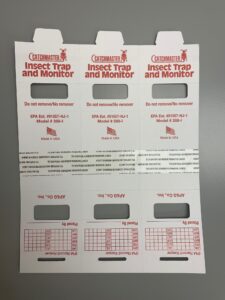Trap selection is an important component of any trapping and monitoring program within an integrated pest management program. Improper selection of a trap style can lead to misrepresentation of a true pest numbers in an area. This is due to the fact that pests may:
- Not be able to enter a trap to be captured because of an inability to fly or crawl into the trap because of its design.
- The pest is able to escape the trap once it enters because of the design.
For example, if you use a suspended hanging trap to monitor when the main pest is a beetle that rarely flies.
A second example would be using a glue trap that has only a thin glue surface to try to capture rodents or large insects that can easily pull themselves from the glue once they enter the trap.
The result of both of these is a monitoring program that is not collecting reliable information.
Before deciding what style of trap to use, put some thought into what type of pests your facility has seen in the past. It might be good to mix it up a bit by having different styles. If you only have the budget for one trap style, pick one that can capture both crawling beetles and flying moths. Don’t be afraid to change trap styles if the one you are currently using is not performing well.
- Trapper Monitor: This trap style works well to give an indication of what crawling insects are passing through an area. Not to be used as a rodent trap!
- Stealth Trap: Great all-purpose trap for crawling and flying insects.
- Rodent Glue Trap: Thick glue layer can trap rodents and large insects. This trap will also capture smaller insects but not recommended for pheromones.
- Diamond Trap: Hanging traps to be used with pheromone lures for strong flying moths and beetles only.

